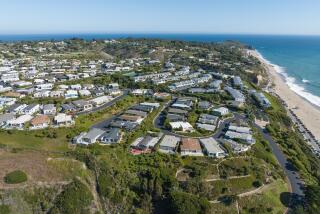With its sun-drenched image immortalized in Beach...
With its sun-drenched image immortalized in Beach Boy songs, trashy novels and TV movies, Malibu’s status as a favored haunt of the rich and famous has soared with the years.
Malibu is a name synonymous with sun, surf and stars. It has also given its name to a Chevrolet, an after-dinner drink, a bicycle, a cigarette and a surfboard style.
It stole Hawaii’s thunder as the birthplace of surfing. Throughout the late 1950s and ‘60s, the surfing life style at famed Surfrider Beach inspired a rash of films like “Gidget” and “Beach Blanket Bingo.”
Two years before it gained its independence from Los Angeles County in 1991, it became notorious as a celebrity-studded sanctuary for the homeless, after honorary mayor Martin Sheen--to the dismay of many public officials--declared the town’s legendary sands open to those less fortunate. Johnny Carson joked on “The Tonight Show” that the town’s well-heeled celebrities were offering to pay for valet parking and free sun block for Malibu’s transients.
Underneath its glitzy veneer, the tiny colony of 19,000 risks flames, floods and mudslides to live amid breathtaking beauty. State experts say it is the most fire-prone place in the country, with fires striking about once every seven to 10 years since 1945.
Privacy is fiercely guarded among Malibu’s glitterati, which includes Barbra Streisand, Bruce Willis, Demi Moore, Tom Hanks, Nick Nolte, Anthony Hopkins, Charles Bronson, Dick Van Dyke, Tom Arnold, Pamela Anderson ... and the list goes on.
Malibu Inside Out * THE ROCK THAT TERRORIZED MALIBU: In 1979, a rock that had threatened to topple onto Pacific Coast Highway for years was removed when workers threw a steel net over the 116-ton sandstone monster and pulled it off its 200-foot perch. Brett-Livingstone Strong, sculptor to the stars, took a 12 1/2-ton chunk and fashioned the likeness of actor John Wayne. The statue later went on display in Century City and outside Mann’s Chinese Theater. An Arizona businessman bought the likeness for $1 million and eventually donated it to Lubbock Christian University in Texas.
* PINK LADY: A 60-foot-tall painting of a naked maiden appeared in 1966 above the tunnel on Malibu Canyon Road. Spectators gathered by the hundreds to gaze at the dancing figure and admire the work of its creator, artist Lynne Westmore, who with acrobatic derring-do suspended herself from ropes to paint the piece. But officialdom deemed the long-haired maiden a traffic hazard, and rubbed her out with spray-paint guns.
* BUMPER CROP: A bumper sticker that read “Malibu: Where the slide meets the tide” was a hot item in the 1980s, poking fun at the enclave’s propensity for landslides.
* MALIBU JOE: Near the corner of Pacific Coast Highway and Cross Creek Road, in a clump of oleander behind a gas station, stands a plaque in honor of Joe Castello or Costello (he gave both versions), a 96-year-old homeless man, who lived outdoors at that spot for 30 years before he was beaten to death and robbed in 1988. Joe is remembered by locals as a rugged individual who thumbed his nose at material ostentation and refused to accept handouts.
* THE SURF SOUNDS LOUD: For more than 5,000 years, a Chumash Indian village existed where the Malibu Lagoon meets the sea. On Oct. 10, 1542, Juan Rodriguez Cabrillo, the first Spanish explorer of Alta California, stayed there for three days, replenishing his expedition’s water and supplies. The villagers greeted Cabrillo’s ships in swift red-planked canoes that so impressed the conquistador that he dubbed the village Pueblo de las Canoas. The Chumash, however, called their village Humaliwu, meaning “the surf sounds loud.” The city’s name is derived from the Chumash word.
(BEGIN TEXT OF INFOBOX / INFOGRAPHIC)
City Business
Date founded: March 28,1991
Area in square miles: 20
Number of parks: 3
Number of city employees: 26
1995-96 budget: $8.5 million
*
By The Numbers
People
Population: 14,233
Households: 5,320
Average household size: 2.39
Median age: 37.9
*
Ethnic Breakdown
Asian: 3%
Black: 2%
Latino: 6%
White: 89%
*
Money and Work Median household income: $80,198
Median household income / L.A. County: $34,965
Median home value: $701,700
Employed workers (16 and older): 8,592
Women in labor force: 60.5%
Self-employed: 1,452
Car- poolers: 631
*
Number of Cars Per Household
One: 23%
Two: 38%
Three or more: 38%
None: 1%
Source: Claritas Inc. Household expenses are averages for 1994. All other figures are for 1990. Percentages have been rounded to the nearest whole number.
More to Read
Sign up for Essential California
The most important California stories and recommendations in your inbox every morning.
You may occasionally receive promotional content from the Los Angeles Times.










